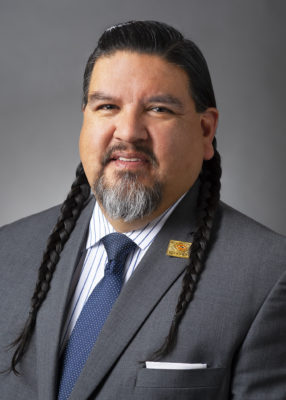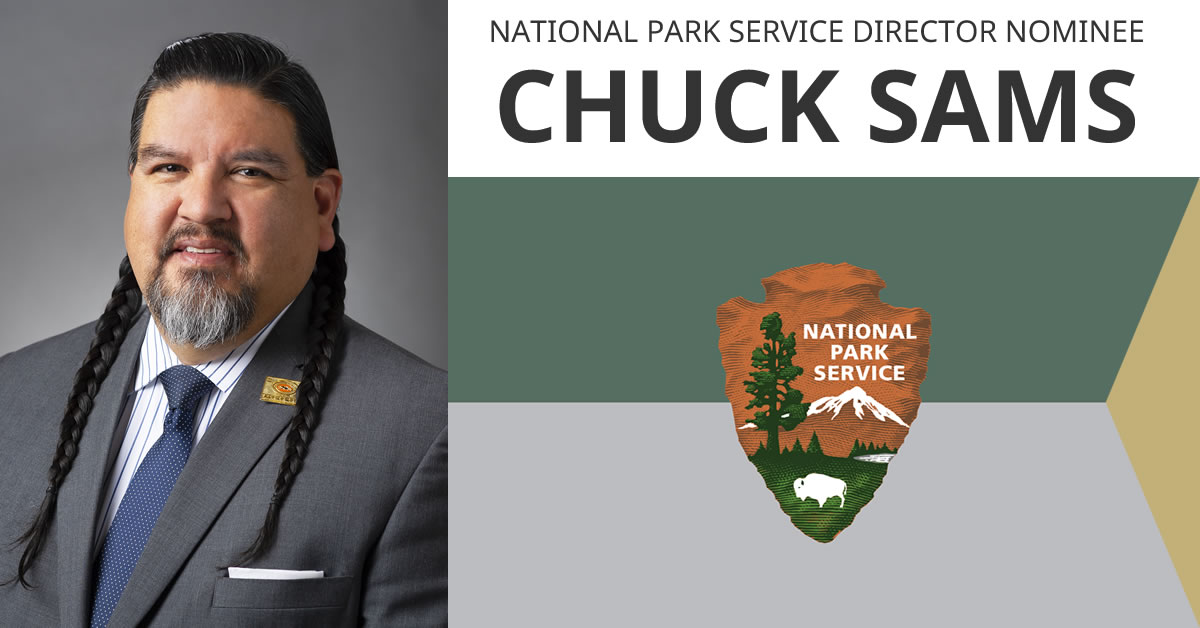Charles F. Sams will become the first Native American to serve as director of the National Park Service, serving under U.S. Interior Secretary Deb Haaland, herself the first Native American to head the federal government’s largest land management agency, if confirmed by the United States Senate.
Sams, an Oregonian, was nominated Wednesday by President Joe Biden, one of the few Pacific Northwesterners to be tapped so far for positions requiring the Senate’s consent in the administration. He is the former deputy executive director of the Confederated Tribes of the Umatilla Indian Reservation and presently a member of the Northwest Power and Conservation Council.

Washington has three national parks (Olympic, Mount Rainier, North Cascades), Oregon one (Crater Lake) as well as such properties as Lake Roosevelt National Recreation Area and the Whitman Mission National Historic Site near Walla Walla. Idaho shares a few NPS units with Washington and Oregon and has a few of its own, like Craters of the Moon National Monument.
Oregon Governor Kate Brown, who named Sams to the Conservation Council, cheered the nomination, saying in a statement:
“I have worked closely with Chuck for many years and have witnessed firsthand his unparalleled devotion and service to his tribe, our state and our nation. Perhaps most importantly, Chuck is a passionate student and teacher of the history and culture of our lands and people.”
As a tribal official, Sams has been in the middle of debate over that history – namely the century-old demonization of tribes for the 1847 killings of missionaries Marcus and Narcissa Whitman. The Umatilla Tribes have constructed a 45,000 square foot Tamastslii Cultural Institute that explains how white settlement robbed local tribes of their land and circumstances that led to the killings.
in In words of author Blaine Harden in his new book Murder at the Mission: “A placard inside the museum tells visitors why the Cayuses decided that Marcus Whitman needed to die: ‘The headmen met in a council and made an agreement that the Doctor should be killed because two hundred of the people had died after taking his medicine.”
After years of deification of the Whitmans, the National Historic Site, in Harden’s words, “now offers visitors a nuanced and historically accurate account of the murders at the mission.”
Washington’s Legislature recently voted to replace a statue of Marcus Whitman as the U.S. Capitol with a likeness of Native American leader Billy Frank, Jr.
“I think there’s already a deal in progress to give tribes co-control of the Whitman site,” Harden said Wednesday night.
The National Park System is America’s gift to the world, starting with creation of Yellowstone National Park in 1872.
The crown jewels of our nation’s public lands have never been the private hunting preserves of royalty, aristocracy or party bosses. Indeed, the Rockefeller family played a major role in creation of Grand Teton and Acacia National Parks.
The Northwest’s national parks are taking on new recognition and drawing new crowds. A national survey recently ranked Olympic National Park as premier unit in the system for its combination of mountains, rain forests and wild ocean beaches. The result: lines at the backcountry permit desk at the Port Angeles visitor center. Reservations and permits are required at such fabled destinations as High Divide-Seven Lakes Basin.
Climate damage is also taking a toll.
Glaciers are melting at the eponymous Glacier National Park in Montana, with the near disappearance of such attractions as Grinnell Glacier. Popular Anderson Glacier in Olympic National Park has disappeared in the last quarter-century.
Visitors to Denali National Park in Alaska witness “drunken forests” where the melting of permafrost has caused trees to lean in different directions.
The parks have been fiercely defended. Gone are the days when Floyd E. Dominy, director of the U.S. Bureau of Reclamation, wanted to build two dams in the Grand Canyon, one of which would have inundated Lava Falls, the canyon’s greatest rapid. The Sierra Club ran a famous newspaper ad headlined: “Would you flood the Sistine Chapel so tourists could get closer to the ceiling?”
Still, Sams will confront development and commercialization pressures, along with crowding that has led to Full-Up signs at the entrances to national parks in the Southwest. The National Park Service has a big backlog of needed maintenance, which each successive administration in Washington, D.C. promises to address. Candidate George W. Bush used Monroe, Washington, in 2000 as site for a speech promising more money for national parks. Didn’t happen.
Some good projects have gone ahead since the turn of the century, such as removal of two aged dams on the Elwha River, the Olympic Peninsula’s master stream, which blocked upstream fish migration. Chinook salmon are now making their way past the site of the once two hundred and ten foot-high Glines Canyon Dam, and into seventy miles of reclaimed salmon spawning habitat.
On the other side of the Salish Sea, wolves have migrated south from Canada and repopulated the North Cascades National Park complex and surrounding lands of the Pasayten and Chelan-Sawtooth Wilderness Areas.
Grizzly bears have staged a dramatic recovery in the Greater Yellowstone Ecosystem. The Trump regime nixed a grizzly bear recovery project in the North Cascades, which ought to be back on the table.
Our national parks have even witnessed nomenclature debates.
Mount Rainier is named after a British admiral who fought “the colonies” in the Revolutionary War. Many would like to see a restoration of the mountain’s native name of Tahoma. After decades of resistance by the Ohio congressional delegation, President Obama acted to restore the native name “Denali” (the high one) to what had been Mount McKinley.
Active in a variety of conservation causes, Charles Sams will have an overriding responsibility in his new job – stewardship. It is laid out in tribal tradition, but also in memorable words spoken by President Theodore Roosevelt, who would go on to designate the Grand Canyon a national monument:
“Leave it as it is. You cannot improve it. Not a bit. The ages have been at work on it, and man can only mar it. What you can do is keep it for your children and your children’s children, and all who come after you, as one of the great sights which every American, if he is able, can see.”

